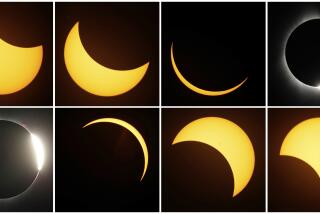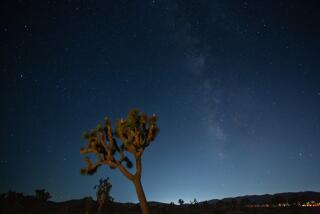Book Review : Astronomer Takes a Shot in the Dark
- Share via
Darkness at Night: A Riddle of the Universe by Edward Harrison (Harvard: $25; 293 pages, illustrated)
Life offers an unending supply of fascinating and intriguing questions that are as pleasurable to think about as they are difficult to answer:
What is consciousness? What is time? What makes an action right or wrong? Why is there something rather than nothing? Where do socks go that disappear in the washing machine? And so forth.
In “Darkness at Night,” Edward Harrison, an astronomer and physicist at the University of Massachusetts, Amherst, discusses yet another question in this bedeviling list, namely: Why is the sky dark at night?
At first, this may not seem like much of a question at all. The sky is dark at night because the sun is not shining. Yes, but what about all those stars? Why do they appear just as points of light with so much darkness in between? Why don’t they light up the sky at night as the sun does in the daytime?
Since there are so many stars in the universe--billions and billions--why don’t they blend into one continuous whole? An infinity of stars in an unbounded universe should cover the sky.
Forest and Trees
Harrison uses a very good analogy to make the situation clear: If you stand in a forest and look around, everywhere you look, you see trees. Some are closer and some are further away, but no matter where you look, sooner or later, your vision is blocked by a tree. They form a continuous background of trees without any gaps. Why don’t the stars at night appear the same way?
Harrison did not invent this question. Far from it. As his thoughtful book makes clear, the ancients thought about it, too, and so have many people along the way from them to us.
The possible answers fall into two categories, Harrison explains: either stars are missing or starlight is missing. Not until the 19th Century, however, was a good explanation put forward, and not until this century has there been an answer that withstands rigorous scrutiny. And even with that, Harrison concedes, “I must admit, I still do not know all the answers.”
He is sure of this much, though: “The sky is dark at night because of missing stars and not because of missing starlight.”
Telling this story requires Harrison to review the cosmologies of the last 25 centuries and to show how in each age, people answered the question of the dark night by referring to their picture of the universe. Things really heated up after Copernicus correctly placed the sun in the center of the solar system. This put astronomers on the path to realizing that the universe was much, much larger than they had previously thought.
Too Far Away
In the 16th Century, Thomas Digges concluded that most of the stars were too far away for their light to be seen on Earth. “What could be more natural, given the state of optical science in the sixteenth century, than the simple idea that the most distant stars, despite their great number, were too faint to be seen?” Harrison asks.
However, this is not the right answer. “This argument,” Harrison explains, “assumes correctly that rays from individual distant stars are much too weak to register an impression on the eye, but assumes incorrectly that the combination of rays from numerous stars is also too weak.”
One by one Harrison takes up more than a dozen explanations that have been offered for the dark sky at night and shows how they were plausible but incorrect.
Finally, in the 19th Century, Edgar Allan Poe, who was an amateur astronomer in addition to being a poet and writer, got on the right track, and Lord Kelvin made a more rigorous application of his idea.
In the 20th Century, astronomers discovered that the universe is expanding, and this provided the key to the first real explanation of why the sky is dark at night. Stars that are very far away from us are moving away from us very rapidly indeed, and this movement causes light from them to shift toward the red end of the visible spectrum. This phenomenon is called the red shift.
Cosmic Expansion
“Starlight from distant galaxies arrives feeble and red,” Harrison writes, “and the feeblest starlight arriving from the farthest galaxies is red-shifted into invisibility. According to this explanation, multitudes of stars actually cover the entire sky, but most of them cannot be seen because their light is red-shifted into invisibility by cosmic expansion.”
But, it turns out, that’s only part of the story. Harrison concludes the book by offering what he considers a still better explanation, which relies on Einstein’s discovery that energy and matter are interchangeable.
According to Harrison, there isn’t enough matter in the universe to light up the nighttime sky. “A bright starlit sky requires 10 billion times more energy than can be obtained by the drastic measure of converting all matter into radiation,” he says. “A bright starlit sky requires at least 10 trillion stars for every star now shining. . . . This solution overrides all other proposed solutions.”
There are many areas of science--and of all scholarship--in which the process of discovery is at least as interesting as the answer that is discovered, and this appears to be one of them. Harrison explains in detail the thought processes of many scientists all along the way and shows how reason and experiment continually interact to produce new knowledge.
Parts of the book are tough going, but other parts are remarkably accessible. What isn’t clear can be skipped without losing the thread of the story. Harrison is a patient explainer, and, though he offers what he considers the best explanation yet, he concedes that there may still be a better one.
More to Read
The biggest entertainment stories
Get our big stories about Hollywood, film, television, music, arts, culture and more right in your inbox as soon as they publish.
You may occasionally receive promotional content from the Los Angeles Times.










